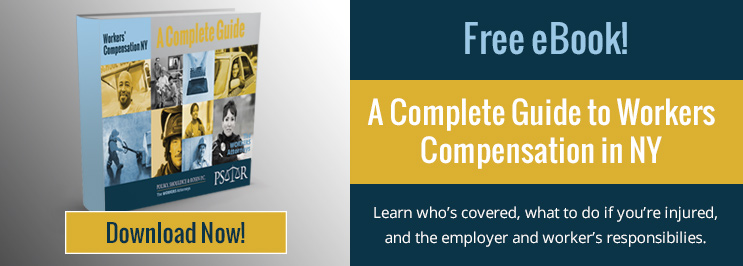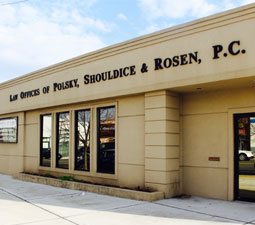New York Workers' Compensation Lawyer
When people think of work-related injuries, they often think of one-time accidents, or ‘traumas.’ An example of these traumas would be when a waiter slips and falls on a wet floor or a truck driver has an accident on the road.
But in some cases, your job can cause health problems that develop over time. With these ‘occupational diseases’ or ‘occupational illnesses,’ you can be entitled to the exact same Workers’ Compensation benefits that you would be if you were to suffer a one-time trauma.
What Is An Occupational Disease?
Simply put, occupational diseases and illnesses are work-related health problems that develop or get worse over time, because of:
- Conditions in your workplace
- Your job duties
- Materials or stressors that you are frequently exposed to
An important fact to note is you do not have to miss work to have an occupational disease or illness or to even file a Workers’ Compensation claim. You may have suffer a workplace accident and still be able to work. Similarly, with occupational diseases and illnesses, you may still be able to work through the pain. At first the pain can be bearable, but over time these aches and pains can turn into bigger issues. This is why it is important that you do not see your pain as being part of your job.
Common Occupational Diseases and Illnesses
In the U.S., some of the most frequently reported occupational diseases and illnesses include:
-
- Noise-induced hearing loss
-
- Carpal tunnel syndrome
-
- Asthma
-
- Joint injuries
-
- Lead poisoning
-
- Cancer
-
- Mesothelioma (a specific type of cancer often caused by asbestos exposure)
-
- Other respiratory diseases
- Post-traumatic stress disorder (PTSD)
What Causes These?
In many cases, these ailments are caused by exposure to dangerous materials or conditions, which include:
- Asbestos
- Carcinogenic (cancer-causing) chemicals
- Pesticides
- Radiation
- Toxic gases and fumes
- Dust and small particles that are inhaled
- Extreme heat or cold
- Loud or ongoing noise
- Repetitive stress – such as data entry, typing, jack hammering, lifting (see more about repetitive stress injuries)
Sadly, many job-related health conditions are preventable, assuming the proper safety precautions, protective equipment and training techniques are used.
Why Is Asbestos Exposure So Dangerous?
Asbestos is a sneaky material, as it cannot be smelled, tasted, or seen. Many of those who are exposed to this harmful material do not have any reactions to it right away. Asbestos exposure is dangerous because a person can inhale or ingest asbestos dust and not even know it until years later. As soon as asbestos material gets inside the body system, it never dissolves and is difficult to expel. Over many years, asbestos fibers trapped inside a person’s body can lead to scarring, inflammation, and genetic cell damage.
How long does asbestos stay in the body before an illness develops?
Illnesses related to asbestos material can take a couple decades or longer to develop in the human body. This means, that once a person has been diagnosed with asbestos exposure, it can be difficult to track back to the exact area which caused such damage to occur. Many asbestos exposure cases that are diagnosed today, were due to unsafe environments that were not regulated at the time.
What is the primary cause of asbestos-related illnesses?
A: Occupational exposure is a leading cause of illnesses related to asbestos. A worker who is unknowingly inhaling these harmful substances, may also carry it home on his or her work clothing (resulting in secondhand exposure). Asbestos illnesses may develop in people who have lived in a contaminated environment such as a home or while using unsafe consumer products that contain asbestos.
Where in the home may asbestos material be present?
A: It can be scary to imagine that your home has areas with asbestos. However, it is better to find out now and resolve the issue, instead of learning years down the line once you have been diagnosed with a related condition. Older buildings, homes, and other properties are more at-risk for having asbestos material in the following areas:
- Roof felt and shingles
- Window putty
- Vermiculite insulation
- Vinyl flooring material
- Textured paint
- Sprayed-on ceiling material
- Covers for heat sources
- Door gaskets
- Duct lining
- Recessed lighting
- Fuse boxes
- Wiring insulation
- Outlets
- Freezers
- Refrigerators
- Range hoods
- Portable heaters
- Hair dryers
- Wood stoves
- Fireplace logs
- Brake Linings
- Clutch facings
When is asbestos the most dangerous?
A: There is no level of asbestos that is considered safe. But, asbestos can be at its most dangerous when someone is around a large concentration of the material, in addition to being exposed regularly over a long duration of time. Asbestos continues to accumulate in the body as it is ingested or inhaled.
What illnesses are most commonly associated with asbestos exposure?
A: Asbestos exposure can eventually lead to chronic and severe diseases. A person who has been around a high quantity of this material may later in life be diagnosed with asbestosis, pleuritis, or chronic obstructive pulmonary disease (COPD). Patients with such conditions may have trouble breathing, particularly if their lungs have become inflamed. Asbestos may also lead to illnesses such as pleural mesothelioma, peritoneal mesothelioma, and lung cancer. Asbestos is the top cause of occupational cancer.
How Workers' Compensation Can Help
If you develop a condition like those mentioned, you may be able to collect Workers' Compensation’ benefits to help cover your lost wages, medical bills and vocational rehab.
But it is important that you get medical care and file your claim in a timely manner. The longer you wait, the harder it is to prove that your job caused your health problem.
For example, lets say you have developed noise-induced hearing loss or tinnitus (ringing in the ears) from working in a firehouse or at an airport. However, you also like to go to concerts. If you wait to file a claim, your boss can argue that it was the concerts, not the sirens or noise from the runway at the airport, that caused your hearing problems.
Time Limits For Filing A Hearing Claim
For occupational hearing loss, the guidelines for filing a claim differ from other types of injuries. In the eyes of the law, the ‘date’ your disability began is either:
- Three months after you were removed from the damaging noise
- Three months after you left the job where you were exposed to the noise
After these dates, regular Workers’ Compensation statues will apply to your case.
Do You Need A Lawyer?
It is not required that you use a lawyer to file a Workers’ Compensation claim, but it can be incredibly helpful and impact the success of your claim. This is especially true for conditions that develop over time and are not caused by an obvious, one-time incident like a machine malfunction.
Disclaimer: For informational purposes only. This is not a substitute for legal advice. If you need legal advice please contact us.
Client Review
"My experience with the law firm is great I recommend five star .in outstanding job Polsky,Shouldice &rosen is the best law firm for all working related injuries.great job ."
Rayan Walker





